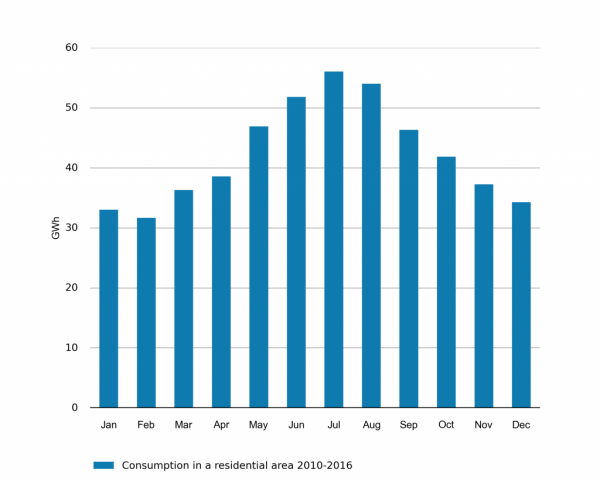
Different factors can affect electricity prices, such as how much electricity you use, how many people in your neighbourhood are using it, and how it was generated.
There are a few reasons why your power bill may increase as the weather gets colder.
1. We use more electricity in winter
For the large majority of people who are on fixed-price contracts, the only reason their bill will go up in winter is that they are using more electricity.
People use more electricity in winter because they want to be warm—they turn on their heaters and electric blankets and take hot showers.
The more electricity you use, the higher your power bill will be.
As you can see in the graph below, a residential area consumes more electricity during the winter months.

2. There’s more than just the cost of generating electricity that goes into your power bill
Before it gets to your house, electricity travels from the electricity generator, through the transmission grid (big powerlines in the countryside), and into the local networks (powerlines in your street).
When lots of people use their heaters during a cold snap, lines companies face higher costs because they pay a fee to use the transmission grid—and they have to use the grid more if lots of people are trying to keep warm. Lines companies pass these costs onto retailers, who can choose how to pass the costs onto consumers.
In most cases, electricity retailers buy electricity from the wholesale market and sell it to consumers. When you pay your power bill every week or month, your money isn’t just going to your retailer—portions of your bill also pay for the cost of generating electricity and the cost of bringing it to your house.
Retailers have a number of options about how they set prices for consumers. Some choose to ‘even out’ their price structure, ie, set one price that covers them for changes in the prices over a year. Whereas, others pass on the price of electricity at the time the consumer is using it - often referred to as a spot price contract.
3. Generation costs can change
When electricity consumption increases in winter, generators have to supply more electricity to keep up with demand.
In New Zealand, we rely on renewable generation, such as hydro and wind. And that’s usually enough to keep electricity prices fairly stable because a renewable generation has lower running costs. But when electricity demand increases in winter, we often need to use other fuels to generate electricity.
In these circumstances, thermal generation sources, such as gas and coal, are used to make sure the lights (and heaters and electric blankets) stay on. But gas and coal generation is more expensive to buy and run, and those extra costs are reflected in the wholesale market (where retailers buy electricity to sell to customers). So the retailers may pass the cost onto consumers.
Consumers who have chosen wholesale or ‘spot price’ electricity supply will see their power price change when generation costs change. These people make up around two percent of households.
Source: Electricity Authority



Get in touch to book a job or request free, no obligation advice.
Tell us a little about you and the project and we’ll be in touch, fast!